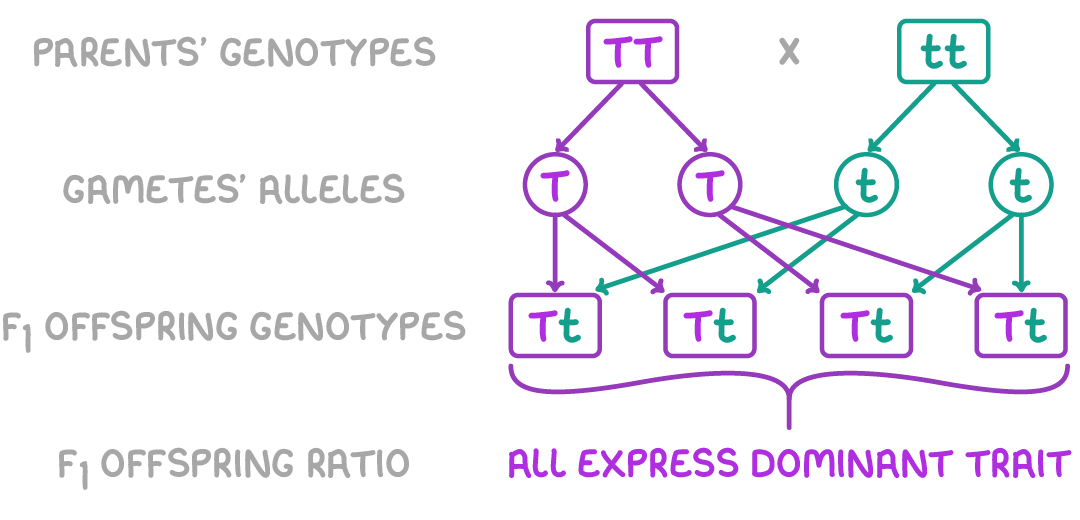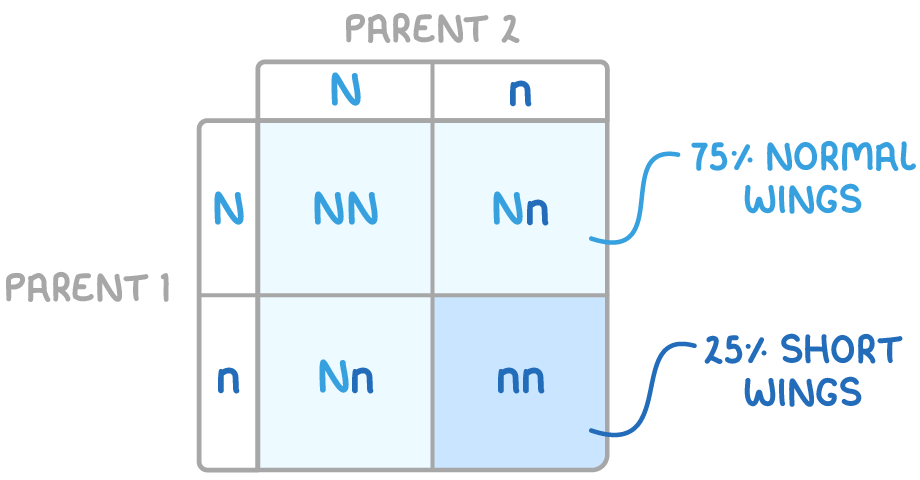Monohybrid Inheritance
This lesson covers:
- Essential genetics vocabulary
- Monohybrid crosses in genetic diagrams and Punnett squares
- What a test cross is
Essential genetics vocabulary
Genetics is the study of genes and how characteristics are inherited.
To understand genetics, you first need to get to grips with some key terminology.
| Term | Definition |
|---|---|
| Gene | A sequence of bases on a DNA molecule that codes for a protein (polypeptide), which results in a characteristic, e.g. a gene for eye colour |
| Allele | Different versions of the same gene that code for variants of a characteristic. Represented by letters, e.g. B = brown eyes, b = blue eyes |
| Genotype | An organism's genetic makeup - its alleles, e.g. BB, Bb, or bb |
| Phenotype | An organism's physical characteristics as determined by its genotype and environment |
| Dominant | An allele that is always expressed in the phenotype, even when only one copy is present in the genotype (shown with an uppercase letter) |
| Recessive | An allele that is only expressed when it is homozygous in the genotype (two copies are present), and is masked by a dominant allele (shown with a lowercase letter) |
| Locus | A locus (plural: loci) is the specific position of a gene on a chromosome |
| Homozygous | An organism with two identical alleles for a trait is homozygous |
| Heterozygous | An organism with two different alleles for a trait is heterozygous |
Monohybrid crosses in genetic inheritance diagrams
Humans are diploid organisms and almost always have two copies of each gene. This means they have two alleles for every characteristic. Gametes (sex cells) are haploid, which means that they have one allele per gene.
Monohybrid (monogenic) inheritance involves the transmission of one gene from parents to their offspring.
A monohybrid cross tracks the inheritance pattern of the alleles for a single characteristic, controlled by one gene with two possible alleles.
Genetic diagrams
Genetic diagrams illustrate how parents can pass on alleles to their offspring. They can be used to predict possible genotypes and phenotypes in the next generation.

The F1 generation:
- This is the offspring from a cross between individuals with homozygous dominant and homozygous recessive genotypes.
- All the offspring will be heterozygous, inheriting a recessive allele from one parent and a dominant allele from the other.
- The offspring in the F1 generation will therefore all express the dominant trait in their phenotype, as shown above.

The F2 generation:
- This is the offspring from a cross between two heterozygous F1 individuals.
- It results in offspring exhibiting a 3:1 ratio of dominant to recessive phenotypes, as shown above.
Punnett squares
A Punnett square represents a monohybrid cross in a grid format. This allows you to predict genotype and phenotype ratios.

To use a Punnett square:
- State the phenotypes of the two parents.
- Assign the genotypes of the parents (e.g. GG for homozygous dominant, Gg for heterozygous, gg for homozygous recessive).
- State the gametes of the parents (e.g. G or g).
- Use a Punnett square to show all offspring genotypes that could be produced from random fertilisation of parental gametes.
- State the proportion of each genotype among the offspring as a ratio or percentage.
- State the proportion of each phenotype among the offspring.
Worked example - Identifying offspring phenotypes using a Punnett square
Short wings are produced in flies that are homozygous for the recessive allele ‘n’. The dominant allele ‘N’ produces wings that are a normal length.
Work out the percentages of different phenotypes in the offspring produced from a cross between two flies that are heterozygous for the wing length trait.
Step 1: Work out the parents’ genotypes and gametes
parents’ genotypes: Nn
parents’ gametes: N and n
Step 2: Input this into a Punnett square and fill in the squares for the offspring genotypes

Step 3: State the percentage of different offspring phenotypes
3 out of 4 of the offspring have the dominant allele so have normal length wings
percentage of offspring with normal wings = 43×100 = 75%
1 out of 4 of the offspring is homozygous recessive, so has short wings
percentage of offspring with short wings = 41×100 = 25%
Note: you may also be asked to present these values as a ratio, e.g. 3:1
What is a test cross?
A test cross involves breeding an organism that has a dominant phenotype but an unknown genotype with an organism that is homozygous recessive. This allows us to determine the first parent's unknown genotype.
There are two potential outcomes of monohybrid test crosses.
- All the offspring have the same dominant phenotype, so are heterozygous (e.g. Tt)
- In this case, the unknown parent’s genotype must be homozygous dominant (TT).
- We know this because the offspring all inherited a recessive allele from the known parent.
- This means they must all have inherited a dominant allele from the unknown parent to all have the dominant phenotype.
- Half of the offspring are heterozygous and half are homozygous recessive (e.g. Tt and tt)
- In this case, the unknown parent’s genotype must be heterozygous (Tt).
- We know this because the offspring all inherited a recessive allele from the known parent.
- This means half the offspring inherited a dominant allele and half received a recessive allele from the unknown parent.
To make a test cross as accurate as possible at identifying an unknown genotype, it needs to be carried out many, many times.
Worked example - Identifying parental genotypes from a test cross
A short pea plant (tt) is bred with a pea plant of an unknown genotype to produce 50% short pea plants and 50% tall pea plants.
Identify the unknown genotype of the parent.
Step 1: Identify possible genotypes of offspring
short offspring genotypes - must be tt
tall offspring genotypes - either Tt or TT
Step 2: Eliminate offspring genotypes based on known parent’s genotype
tall offspring genotypes - cannot be TT, as they inherited one recessive allele from the known parent, so must be Tt
Step 3: Identify the unknown parent’s genotype
given the offspring genotypes of tt and Tt, and the known parent’s genotype of tt, the unknown parent’s genotype must be heterozygous, Tt